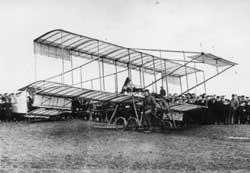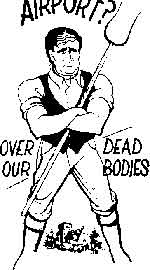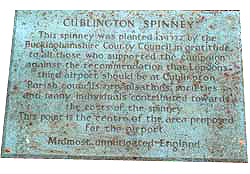|
 |
 |
 |
 |
 |
 |
 |
 |
 |
 |
 |
Wing Airfield
|
|
 |
 |
 |
|
|
|
|
|
|
|
 |
ANTI-AIRCRAFT MEASURES
THE WING AIRPORT RESISTANCE ASSOCIATION
In the early days of aviation, great exitement had been caused when several of the early pioneers of aviation made an inintended acquaintance with the area. William Moorhouse made a forced landing at Fenny Stratford, on perhaps the worlds first commercial flight whilst in pursuit of the Daily Mails £10,000 prize, for the first person to fly a heavier than air machine from London to Manchester, Claude Grahame - White and Louis Paulhan both passed over the district. |
|
 |
|
|
|
|
|
Then, in 1911, Grahame-White again came to the region when he crashed on the farm of John King, at Drayton Parslow. Repairs to the aeroplane were swiftly effected by a carpenter from Stewkley. In later years an autogyro crashed at Stewkley in Foxhole Field and in 1929 more excitement was caused, by the progression of many planes over the village at high speed and low altitude, competing in the race for the Schneider Aviation trophy. World War Two brought the airfields at Wing and Little Horwood into existence, for training bomber crews and as part of the national stuggle the local villages had to put up with the round the clock aerial activity and the many unfortunate but perhaps inevitable crashes. |
|
 |
 |
|
 |
Claude Grahame White at Drayton Parslow
|
|
|
 |
Some 30 years later, however, the local communities proved far less tolerant when proposals to site Londons Third Airport in the region were proposed. In 1963 Stanstead had been recommended as the site but this had been ultimately rejected and in 1969 cublington was included amongst a shortlist of new possible locations. The commissions on The Third London Airport, by the High Court Judge, Mr Justice Roskill had first met in private on June 25th, 1968 and shortly after christmas, 1970, cublington became their firm recommendation to the Government. Then began an intense 2 year battle against the decision by the local communities which achieved global coverage in the press and on T.V.and enlisted the willing co-operation of manyeminent persons. The 'resistance movement' had origins from a meeting, held on the eve of the Roskill announcement, in the drawing room of a local farmer, Bill Manning and there the Wing Airport Resistance Association was born. |
|
 |
|
|
In the following week the officials were inaugurated at a meeting in Winslow and to publicise the cause 40,000 pamphlets as well as car stickers were given out, during the next few weeks. Funds for the campaign (Left, Wing airport resistance poster) were raised from numerous sources from the sale of original fleet street cartoons to beetle drives- and at Stewkley a 'mile of pennies', outside the church, raised a considerable sum. Eventually, after a long and hard struggle, the campaign succeeded and on april 26th, 1971, John Davis, the secretary of state for Trade & Industry, told the House of Commons that the airport would now be built at Foulness Island, Essex.Exuberant celbrations then followed and on B.B.C Television, Panorama opened with a film of the triumphal bonfire at Stewkley. As a permanent celebration of the victory, the Bucks Country Council, following an appeal for contributions, planted a spinney of over 400 trees, on a 3 acre site that would have been the centre of the airport. Oak, elm, horse chestnut, norway maple, London plane & red oak were all included and on March 26th, 1972, the chairman of the Bucks Country Planning Committee officially unveiled the memorial plaque (below).The concluding words'unmitigated England', from Henry James, were applied by the poet John Betjeman, who had been an ardent supporter of the aims & ideals of W.A.R.A. |
|
 |
 |
|
 |
|
|
|
 |
|
|
|
 |
|
|
|
Back to top |
|
|



